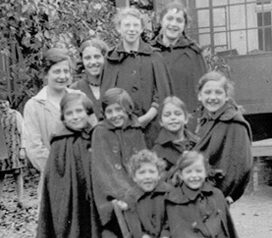The search for biographical data of the residents of the “Heim Isenburg” has become more difficult and costly nowadays. During the pogrom in November 1938 all records got burned in the institution in Neu-Isenburg. The remaining duplicates which were stored in the Frankfurt office of the association “Heim des Jüdischen Frauenbundes e.V.” were lost in the bombing of World War II. The destruction of the records considerably restricts the circle of people who could be included in this memorial book.
For the period of 1907 until the late 1920s data of the home inhabitants preserved as part of the index of residents in the Neu-Isenburg town archives. This register is not fully evaluated yet. In the Neu-Isenburg town archives, the so-called “Jews Index” (“Judenkartei”) is archived. This index includes statements about registration and deregistration and various lists with data of the residents (“Insassenlisten”) that needed to be submitted in regular intervals to the local police authority by the home directorate after the adoption of the Nuremberg Race Laws in September in 1935.
From the sources in Neu-Isenburg Town Archive, an alphabetized database of inhabitants is archived. This inventory was the basis for further research in archives, the International Tracing Service in Bad Arolsen, in other databases and memorial books. The research in state archives were limited to the Hessian State Archives Wiesbaden and the Hessian State Archive Darmstadt. Since the women and children who found shelter in “Heim Isenburg”, came from the entire German Reich, it is expected that more information can be found in the Federal Archives and the archives of other federal states of Germany.
In 2010 when this website came online 471 woman an children were listed in the memorial book. This number increased to more than 650 until the first half of 2017. The destiny of about half of the recorded persons during the Nazi regime could be clarified. Nearly 300 women and children were verifiably deported an murdered. Several women had commited suicide when they received the order of deportation. A few families were deported to Poland in October 1938 and have been missing ever since. About 80 of the inhabitants who lived in “Heim Isenburg” between 1907 and the beginning of World War II were able to escape abroad early enough and some have survived in Germany. Only a few were liberated from the concentration camps in 1945.

